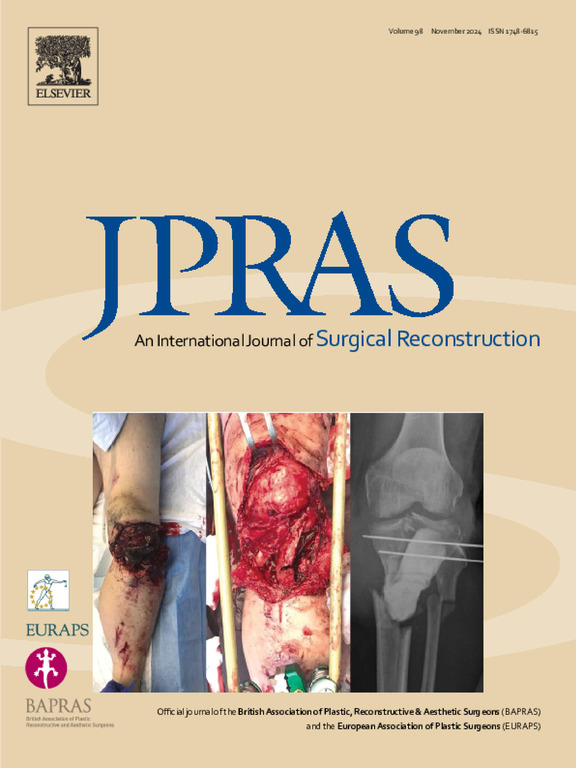Donor site in anterolateral thigh (ALT) free flaps: A systematic review of closure techniques and introduction of a management algorithm
IF 2.4
3区 医学
Q2 SURGERY
Journal of Plastic Reconstructive and Aesthetic Surgery
Pub Date : 2025-04-16
DOI:10.1016/j.bjps.2025.04.008
引用次数: 0
Abstract
The anterolateral thigh (ALT) free flap is widely used in reconstructive microsurgery for its versatility and reliability, yet donor site management becomes challenging when flap dimensions exceed those for tension-free primary closure. The flap width-to-thigh circumference ratio (FW/TCR) is a potentially valuable objective decision-making tool. Given the heterogeneity of the reported closure techniques, this review aimed to map current techniques, identify gaps in evidence and propose a FW/TCR-based algorithm to standardise ALT donor site closure.
A review of PubMed/MEDLINE, EMBASE, Cochrane Library and AMED databases was conducted from inception to October 2023, including English-language studies focused on ALT donor site closures. Data on closure techniques, outcomes, and complications were extracted.
Overall, 27 studies met the inclusion criteria, describing direct primary closure, locoregional flaps, skin grafting, and adjunctive methods such as negative pressure wound therapy, acellular dermal matrices and tissue expansion. Direct primary closure was generally reported as feasible for FW/TCR < 16%. Once FW/TCR exceeded 30%, skin grafting or alternative solutions such as ‘kiss’ (split skin paddle) flaps were more frequently described. In the intermediate range (16–30%), locoregional flaps were commonly employed to avoid graft-related morbidity.
Drawing on these findings, we propose a FW/TCR-based algorithm: (1) direct closure for FW/TCR < 16%, (2) locoregional flaps for FW/TCR 16–30%, and (3) grafting or alternative techniques if FW/TCR exceeds 30%. Standardising closure strategies using these thresholds may reduce donor site morbidity and optimise patient outcomes. Further high-level comparative studies are necessary to validate and refine these recommendations.
股骨前外侧游离皮瓣供体部位:系统回顾关闭技术和介绍一种管理算法
股骨前外侧游离皮瓣因其多功能性和可靠性被广泛应用于显微外科重建,但当皮瓣尺寸超过无张力初级闭合时,供区管理变得具有挑战性。皮瓣宽度与大腿围比(FW/TCR)是一种有潜在价值的客观决策工具。鉴于报道的缝合技术的异质性,本综述旨在绘制当前的技术,识别证据中的差距,并提出一种基于FW/ tcr的算法来标准化ALT供区缝合。对PubMed/MEDLINE、EMBASE、Cochrane Library和AMED数据库进行了回顾,从建立到2023年10月,包括关注ALT供体网站关闭的英语研究。提取缝合技术、结果和并发症的数据。总的来说,27项研究符合纳入标准,描述了直接初级闭合,局部皮瓣,皮肤移植和辅助方法,如负压伤口治疗,脱细胞真皮基质和组织扩张。据报道,直接初级关闭对于FW/TCR <是可行的;16%。一旦FW/TCR超过30%,则更频繁地描述皮肤移植或替代解决方案,如“吻”(分裂皮肤桨)皮瓣。在中等范围内(16-30%),通常采用局部区域皮瓣来避免移植物相关的发病率。根据这些发现,我们提出了一种基于FW/TCR的算法:(1)FW/TCR <的直接闭包;(2) FW/TCR为16-30%的局部皮瓣,(3)FW/TCR超过30%的移植或替代技术。使用这些阈值标准化闭合策略可以减少供区发病率并优化患者预后。需要进一步的高水平比较研究来验证和完善这些建议。
本文章由计算机程序翻译,如有差异,请以英文原文为准。
求助全文
约1分钟内获得全文
求助全文
来源期刊
CiteScore
3.10
自引率
11.10%
发文量
578
审稿时长
3.5 months
期刊介绍:
JPRAS An International Journal of Surgical Reconstruction is one of the world''s leading international journals, covering all the reconstructive and aesthetic aspects of plastic surgery.
The journal presents the latest surgical procedures with audit and outcome studies of new and established techniques in plastic surgery including: cleft lip and palate and other heads and neck surgery, hand surgery, lower limb trauma, burns, skin cancer, breast surgery and aesthetic surgery.

 求助内容:
求助内容: 应助结果提醒方式:
应助结果提醒方式:


